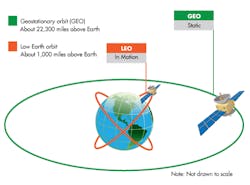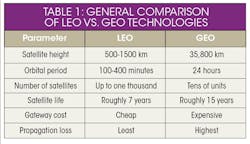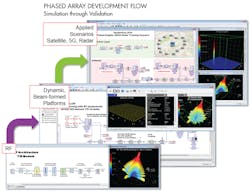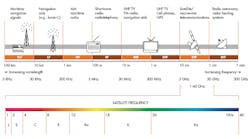Is the Internet of Space Technically and Economically Viable?
This file type includes high resolution graphics and schematics when applicable.
Most everyone has heard of the Internet of Things (IoT), where connectivity to people and things comes from Earth-bound wired and wireless networks. But fewer technologists know about the evolving Internet of Space (IoS), where connectivity comes from space-based satellites and—in the near future—lower altitude airborne platforms based on drones and even balloons. This article will look at the controversy and challenges surrounding the IoS, from the phrase itself to the technical RF and microwave issues, the business model viability, and finally the competition with terrestrial 5G and LTE networks.
Before considering the technical and business viability of the Internet of Space, we must first clarify the controversy surrounding the phrase itself. To many people, IoS refers to Apple’s mobile phone operating system, or the iOS. To IT professionals, the Internet of Space often refers to the architecture and topology of computer systems, where the physical or core processor exist in the space or clouds around us, all of which have an Internet Protocol (IP) address.
Conversely, microwave and RF engineers would probably recognize the Internet of Space as a reference to satellite-based technology. For the last several decades, many wireless devices have been designed to service communication satellite Ka- and Ku-bands. Indeed, the IEEE has noted an increase in interest and investment in space and suborbital-based high-data-rate communication networks. They label this technology as the Internet of Space and note that the primary goal of the IOS network is to deliver high bandwidth information to every part of the world.1
In 2016, the IEEE MTT Society initiated a major discussion of the IoS during the International Microwave Symposium in San Francisco. The essence of this discussion among the major satellite and RF-microwave vendors and investors will be highlighted shortly.
IOT vs. IOS
Today’s Internet of Things (IoT) is connected via wired and wireless Earth-based networks. But with the insatiable hunger for ever higher data bandwidths, the resulting congestion and slower data rates are becoming common. Adding to these network stresses is the cost viability challenges when connecting remote and underserved regions of the world to the internet.
These factors have led to recent investments in space-based internet platforms. These suborbital, high-data-rate communication networks are being collectively referred to as the Internet of Space (IoS) or sometimes satellite-based IOT (S-IoT). For now, satellites serve mainly as backhaul for hard-to-reach geographic locations and sparsely populated areas.
The Internet of Space is comprised of a variety of satellites at different orbits and potentially lower-altitude airborne platforms. Geostationary orbit (GEO) and low earth orbit (LEO) are the two traditional orbits for the IOS (see Fig. 1). GEO satellites are located approximately 22,000 miles above the earth. They follow the direction of the Earth’s rotation and appear as a fixed, static point to any antenna tracking it on the ground. GEO systems are effected by atmospheric refraction, line-of-sight obstructions and other obstacles at the ground observer’s latitude location.
LEO applies to objects in motion approximately 1,000 miles above Earth, which includes all manned space stations and the majority of satellites. LEO satellites travel overhead at all times, instead of tracking with a fixed point on Earth as with GEO ones. Low Earth orbits allow them to provide constant coverage through a collection or constellation of satellites that are closer to Earth, offering lower latency than GEOs. Latency refers to the time it takes for a bit of data to move from sender to receiver.
Low Earth orbits are preferred when low latency is needed. Low orbits also reduce power amplifier requirements and antenna sizes among other things (see table below). However, low Earth orbit global coverage requires large numbers of satellites to cover the planet to ensure continuous data links. It’s not usual for a provider to have up to a thousand satellites in orbit per constellation system. In addition to producing hundreds or thousands of satellites, many more ground terminals are needed to convert the satellite frequency to data or standard terrestrial frequencies like LTE, 5G, or Wi-Fi. To compete with existing IoT networks, both the satellite and terminal costs must be kept very low while reliability must be high. Low-cost solutions in IoS systems require simple and flexible designs, leveraging commercial off-the-shelf (COTS) technology, and efficient manufacturing & testing methodologies.
Backhauland Beyond
From the IoT perspective, the IoS is seen as an evolving communication network. In particular, the IoS can provide critical backhaul for remote locations devoid of cellular or wireless LANs.
Satellite backhaul refers to getting data to a point from which it can be distributed over a network. The backhaul portion of a network connects the backbone or core network to the smaller subnetworks. For example, to deliver a live video program from the West Coast to a satellite terminal (e.g., satellite TV) or handset around the country, the video signals would have to be backhauled by some means (by optical fiber cable across the country or by another satellite system) to the operator of the satellite terminal at the desired location (perhaps somewhere on the East Coast). From there, it would be viewed directly on handsets or uplinked to a satellite from which satellite terminal users (e.g., satellite TV) could view the broadcast by receiving a downlink from the satellite at their individual terminals.
With satellite costs steadily decreasing and demand for data such as video steadily increasing, many operators feel that backhaul and even handset or terminal data over satellite is becoming cost-competitive with terrestrial solutions like fiber optics.
However, not everyone agrees. Maurizio Brignoli, coâfounder and CTO of Avanix srl, a wireless technology company, doesn’t see satellites as yet being cost-effective with 5G and LTE cellular. “SIGFOX and LoRa will be very competitive compared to satellites or low-altitude airborne alternatives like balloons,” he says. SigFox and LoRa are wireless carrier platforms in the terrestrial-based low-power wide-area network (LPWAN) market.
Undoubtedly, the biggest application of satellite backhaul will initially be the connection of remote locations. During the IEEE IMS 2016 panel on the Internet of Space, Prakash Chitre, general manager at Comsat Labs, a division of ViaStat, confirmed that in regions like Africa and South America, the satellite network is the only backhaul to available mobile operator-carriers. “Since there isn’t any fiber backhaul,” he says, “the mobile operators in developing countries must use the satellite. But it takes a lot of our time and effort to make sure that the protocols of the various operator networks are working together [with the satellites].”
But IoS can have applications beyond backhaul. Mark Wallace, senior VP of worldwide sales at Keysight, notes that, “while many IoS data links will require a ground terminal with an antenna and frequency converters to communicate in the high-frequency satellite bands, there are examples where direct connections of IoT to IoS are possible. Companies like Spire are using satellites to connect large IoT assets such as ships traveling across oceans to capture the existing Automatic Identification System (AIS) marine signals, which were originally intended for terrestrial-based reception.”
The overwhelming value of IoT is in enabling the connectivity to “things,” where the overwhelming value of IoS is a ubiquitous access point to the internet, explains Wallace. While there will be many alternate ways for the IoT to connect to the internet infrastructure, IoS will offer unique benefits given its vantage point from hundreds of miles above Earth.
Technical Challenges Abound
Unlike ground-based systems, the Internet of Space relies on satellites as the primary communication mechanism. To compete with terrestrial systems, satellite designers like OneWeb must keep the costs low. The OneWeb satellite constellation is a proposed collection of roughly 648 satellites that are expected to provide global internet broadband service to individual consumers as early as 2019.
Keeping the cost low in the space communication business means keeping technical parameters like weight (or mass) and power as low as possible.
“The only thing that makes satellite mass work is if you figure out the power problem,” cautioned David Bettinger, VP of engineering for the Communications Systems Division at Oneweb during the IoS panel at the IEEE IMS 2016. “Ultimately, we are not selling the bandwidth of our system. We are selling power because we don’t have the luxury of having a huge satellite up there that is designed to power constantly, whether you are in an eclipse or not. We have to effectively manage our power with the subscribers of the service. Power harvesting on the satellite is one of the things we can do. Power utilization drives almost every aspect of our business case.”
As an example of an extremely low-power and efficient system, Bettinger mentioned a 10-W, Ku-band Scanning Spot Beam Antenna (SSBA) device. Several scannable spot beams or a large number of multisport beams are required to provide ultra-high data-rate transmission while simultaneously ensuring wide coverage. In addition, SSBA phased-array platforms have the advantage of being smaller than traditional antenna systems.
There are other subsystem examples besides phased arrays that must be optimized to ensure a competitive IoS dollars-per-bit data link. The main variables to getting higher data rates are more channel bandwidth and more power, explains Wallace. High-throughput satellites (HTS) are one example, which move to higher frequencies (Ka-band) for more available bandwidth and multiple techniques to increase power efficiency. These techniques include using the non-linear portions of amplifiers, spot beams, phased-array antenna, and high-order, custom-ring ratio modulations. Figure 2 highlights the fact that similar modeling tools can be used to simulate RF functionality in both terrestrial and space environments.
2. Similar modeling tools can be used to simulate RF functionality in both terrestrial and space environments.
Evolving semiconductor technologies are also helping to meet the cost, weight, and power trade-offs for satellites. For example, companies are weighing the differences between GaN versus GaS in high bandwidth antennas, low noise amplifiers (LNA) and up-down converters.2
Another hot technology is active steering antennas. Bettinger believes the best approach to reducing cost while increase power efficiency is to make small, cheap chips and then design the antennas around them.
One way to make inexpensive chips is to do so at high rates of production. This is the strategy of RUAG’s space division, a Switzerland based technology company. RUAG is concentrating on the “new space” market. New space is often affiliated with the emergent private spaceflight industry, or the community of relatively new aerospace companies working to develop low-cost access to space or spaceflight technologies.
“You get a lot of cost savings with high-rate production for space technology,” said Michael Pavloff, RUAG Space, CTO, during the IoS panel at the IEEE IMS 2016. “We have moved to a lot of high-rate production for both space and non-space work. For example, our RF frequency converter chip business is coming to a point where 75% of the product will be for non-space applications. Having that type of throughput, handling commercial, non-space grade components, and so forth is key to getting that type of capability of high rate production.”
Lower-cost chips as the latest semiconductor technology are great, but how do you get those up into space? In this case, LEO may have an advantage over GEO implementations. Typically, a LEO satellite is designed for a seven-year life span, while the GEO satellite must stay operational and in orbit for closer to 15 years. This means that LEO vendors must replace their constellation of satellites twice before a typical GEO satellite would be replaced.
“We see this as an opportunity,” notes Bettinger. “Thanks to the shorter lifespan of LEO, we can continue to invest in our payload technology to actually take advantage of technology upgrades. The reality of the GEO satellite is that it has to be extremely reliable and operate flawlessly. That usually means that you must manufacture the satellite for three years before you launch it. So you are using technology that is more than a couple years older than that. We feel that we can put COTS technology into space very quickly. Ultimately, we depend on having the technology refresh opportunity.”
Enabling IOS
Whether satellite-based IOT is used as backhaul or directly connected to end-user terminals (like satellite TV) or handsets, providing internet globally to all users will require a mix of technologies. Most will rely heavily on RF and microwave connectivity, especially in sparsely populated rural and underdeveloped countries.
“You can’t come up with one architecture to provide internet connection to everyone around the world,” explained Hamid Hemmati, director of engineering for Telecom Infrastructure at Facebook during the recent IOS panel at the IEEE IMS 2016. “Each country requires a unique solution.” According to Hemmati, the total throughput required to connect all of the unconnected global users is about 100 Tbps. This calculation assumes that 4 billion people will need a speed of 25 kbps per user to access the internet simultaneously. 100 Tbps will require a very large capacity.
To meet this capacity challenge, the best of each connectivity technology should be selected: space satellites (mainly GEO and LEO), High Altitude Platforms (e.g., drones and balloons), and existing terrestrial networks (like cellular and fiber optics). The same or similar RF and microwave technologies will be used in all of these implementations, so the main differentiator is cost. According to Hemmati, satellite communication becomes practical and comparable to LTE only if you are at multi-Tbsp capacity, otherwise it is much more expensive than LTE. There must be a business justification to implement a satellite-based or high-altitude platform IoT solution. Terrestrial cell tower and fiber optic installations are already available in highly dense population centers, but they are too expensive for rural and underdeveloped countries.
A business case will have to be made to determine which connectivity option is best for a given application in a given geographic region. Technology can help by lowering the cost and power while increasing the performance for any given option.
There is one final caution about the business viability for the Internet of Space. Unlike the terrestrial IoT, the IoS connectivity follows few standards. It’s true that the IoT has either too few or too many connectivity standards—depending upon whom you ask.3 But, for the most part, satellite technology is strictly proprietary or mandatory from the owner of satellite. One example of this is the recent FCC ruling on a specific Ka-band frequency. The disputed Ka-Band frequency is the 28 GHz band (see Fig. 3). Satellite companies have said that they relied on priority access to this band for years and have made substantial investments in that access. Conversely, the 5G community, led by the Wireless Association known as the CITA, claims the satellite operators are effectively squatting on the bandwidth by assuming no other users would use the same spectrum. In its ruling, the FCC acknowledged that there may be the potential for interference between 5G and satellite services.
In summary, the technical and economic viability of the Internet of Space is a tricky question. Improving the technology to be lower cost, lower power, and higher bandwidth will benefit both satellite and terrestrial-based connectivity options. The bigger cost challenge may well be one of infrastructure, specifically, contrasting the cost of fiber optic to satellite backhaul. However, for rural and developing countries, the only real option may be satellites.
References
1. IEEE Internet of Things, “The Internet of Space (IoS): A Future Backbone for the Internet of Things?"
2. Electronic Design, “What’s The Difference Between GaAs And GaN RF Power Amplifiers?”
3. JB Systems, “Competing Consortia Confuse RF-based IoT Market”
Required Technologies for the Internet of Space*
GEO Satellites
- Multi-Tera bit per second (Tbps) capacity RF and optical
- 2× reduction in cost of satellite/payload manufacturing and launch
LEO Satellites
- 10-100 Gpbs capacity RF and Optical
- 10-20× reduction in cost of satellite/payload manufacturing and launch
High Altitude Platforms
- 10-100 Gbps uplink/downlink/crosslink RF and Optical capacity
- Multi-year airborne lifetime
- Less than 0.01% crash rate per year
Terrestrial
- Fiber: Above or underground fiber
- Wireless: RF/mm-wave and Optical band links may become economical for :
- Cost/link reduced by an order of magnitude
- Tower/land/installation reduced by an order of magnitude
- Range between towers ~ 15km
*Courtesy of IEEE IMS 2016 presentation by Hamid Hemmati, director of engineering for Telecom Infrastructure, Facebook. Note: Facebook is not investing in all of the above-mentioned items.
This file type includes high resolution graphics and schematics when applicable.






